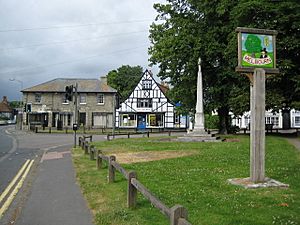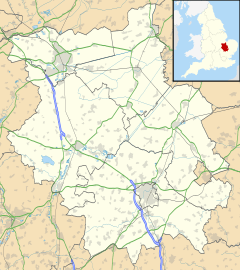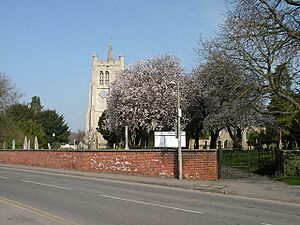Melbourn facts for kids
Quick facts for kids Melbourn |
|
|---|---|
| Village | |
 |
|
| Population | 4,689 2011 |
| OS grid reference | TL385445 |
| District |
|
| Shire county | |
| Region | |
| Country | England |
| Sovereign state | United Kingdom |
| Post town | ROYSTON |
| Postcode district | SG8 |
| Dialling code | 01763 |
| Police | Cambridgeshire |
| Fire | Cambridgeshire |
| Ambulance | East of England |
| EU Parliament | East of England |
Melbourn is a large village in the south-west of Cambridgeshire, England. It is a "clustered village," meaning its buildings are grouped closely together. The main road, the A10, goes around the village. Melbourn is about 3 miles (5 km) northwest of Royston, Hertfordshire, which is a larger town nearby. Over 4,600 people live in Melbourn. It is part of the South Cambridgeshire area.
The Prime Meridian line, which divides the Earth into eastern and western hemispheres, passes just west of Melbourn.
Contents
Melbourn's Long History
Melbourn has been home to people for a very long time. This is because of natural springs at a place called Melbourn Bury. Also, several old paths cross the area. The Icknield Way runs south of the village. Ashwell Street and a Roman road between Cambridge and Royston also follow ancient routes.
- Early Settlers: Pottery and burial sites show that people lived here during the Bronze Age.
- Roman Times: A Roman settlement was found at the north-east edge of the village.
- Saxon Graves: In the 1950s, archaeologists found 28 graves from a Christian burial site. These graves date back to the 7th century and were near Ashwell Street.
- Domesday Book: Melbourn is mentioned five times in the Domesday Book. This was a big survey of England made in 1086.
- Village Name: The name "Melbourn" comes from an older name, Meldeburn. This means "the stream of a man named Melde."
All Saints' Church
The discovery of a Saxon cemetery shows that Christianity has been in Melbourn since the 7th century. The village likely had a small chapel in the 11th century. However, the first official record of a church is from 1152.
The church you see today is called All Saints. It is a Grade II* listed building, which means it is very important historically. A big repair project was done in 1882 by R.R. Rowe. But parts of the church are much older, from the 13th century. These include the arch in the chancel (the area around the altar) and parts of the tower. The font, which is used for baptisms, is even older, from the 11th century.
Life in Melbourn Village
Melbourn has many useful places and services for its residents.
- Schools: There is a primary school for younger children. Older students attend Melbourn Village College, which is a secondary school.
- Science Park: Melbourn is also home to a well-known science park. This is a place where companies do scientific research and development.
- Shops and Services: The village has a butcher's shop and a Co-op food store. You can also find five hairdressers and a barber shop. There are two estate agents, two pubs, and a newsagent. The village also has a sub-post office, two garages, and three churches. These churches belong to the Anglican, Baptist, and URC faiths.
- Sheene Mill: This building is located on the River Mel, just northwest of the village. It used to be a mill but is now a hotel and restaurant. A famous television chef, Steven Saunders, used to own it.
- Train Station: The closest train station is Meldreth. It is in the village next door and opened in 1851. This station is on the Cambridge line.
Village Pubs and Inns
Melbourn was a popular stop for travelers by the 17th century. Records show it had an inn in 1622. By the late 1700s, three inns served the village:
- The Dog (its history is not well known).
- The Red Lion (closed in the late 1800s).
- The Hoops (closed in the early 1900s).
In 1865, Melbourn had 11 inns and pubs! Some of these included the Black Horse, the Star, the White Lion, the Anchor, the Carriers Arms, and the Red Cow. The Rose Inn and the Coach and Horses opened around 1850.
Today, Melbourn has two public houses:
- The Dolphin: This is the oldest pub still open, dating back to 1818.
- The Black Horse: This is the other pub in the village.
See also
 In Spanish: Melbourn para niños
In Spanish: Melbourn para niños



